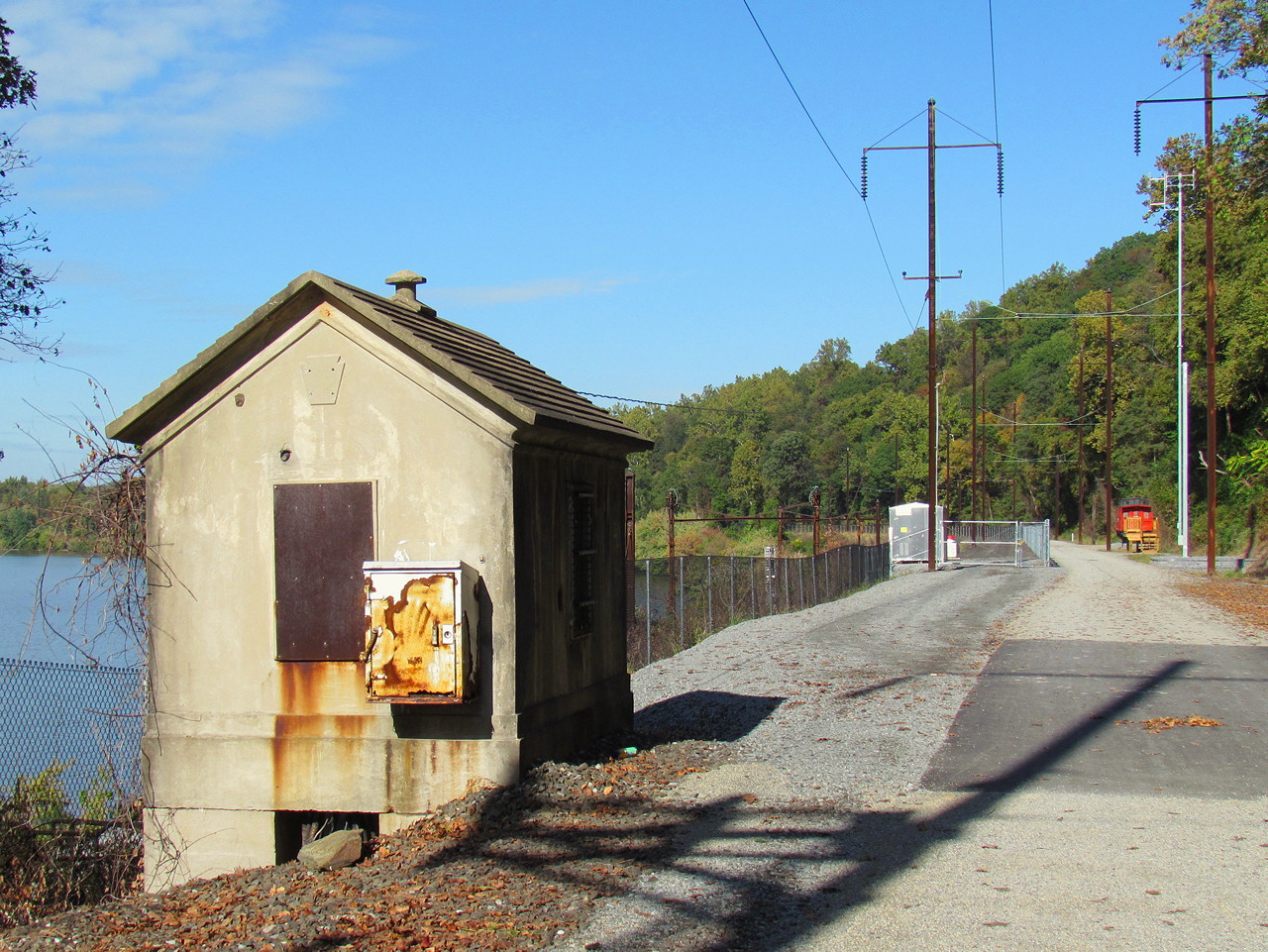MANOR was located about 7000 feet railroad east of COLA's eastern hole signal and served as the east end of the Manor siding track as well as a trailing point crossover. MANOR consisted of two switches, #25 onto the siding and the #23 crossover, and 5 signals controlled by two levers, the #26 for signals on track #2 and the siding and the #24 for signals on track #1. The siding was restricted speed so the 26R was only equipped with a lower head \, the 24L making do with a Stop and Proceed marker. MANOR was removed sometime before 1986 and today there is almost no indication it was there except for the right of way narrowing slightly.
Between MANOR and PORT was the Milepost 35 automatics. Like the automatics between COLA and STELL these were also prefixed with an 'L' before the 2010 resignaling project. The original pair of PRR PL masts were numbered L351 in the westbound direction and L352 in the eastbound direction.
With a restricted speed siding at MANOR diverging movements would get an Approach indication on the L351. Both of these masts were relocated in the Conrail era, as evidenced by the steel caisson for one, as a result of the elimination of PORT. After the removal of MANOR the default indication on L351 remained Approach for a Stop signal at COLA.
In the opposite direction on track #1 the L352 mast was originally the distant to PORT interlocking where trains actually had a choice of routes and therefore a lower head | was provided for Approach Medium indications.
After PORT was removed the signal became the distant to CP-CRESS, where two tracks collapsed into one after the A&S flyover. Track 1 drew the short straw and was signaled for a diverging move. Without the "straight' route at PORT the best indication that L352 can display is Approach Medium with the default being Approach.
After the 2010 resignaling these were replaced by a pair of bi-directional Darth Vaders. Track #1 has the somewhat uncommon distinction of having a full lower head in the westbound direction to support the slow speed movements at COLA. The L prefix has been removed from the number plate. Note the old signal brackets on the catenary masts which are from the original L351/L352 placement. I guess what's old is new again.
As we move to PORT and CRESS we also move to a new interlocking chart. PORT is the junction of the A&S "Low Grade" line and the Port Road. As previously discussed the A&S was built in 1906 to provide an alternate route around the stiff grades on the Main Line between Atglen and Lancaster, including the high point of the Main Line at Gap, PA.
PORT is one of the tradmark PRR Flying Junctions and compared to a flat junction PORT lacks the crossovers and/or diamonds such as were encountered at STELL. PORT contained only two switches, #13 and #17, and two trios of signals, the #14 for eastbound trains and #18 for westbound. Turnouts were both medium speed and driven with pneumatic point machines. With the A&S removed PORT was straight railed for the Port Road, but unlike MANOR traces of the old interlocking still remain. Here we can see the old PORT relay hut and the bracket for the 14L signal.
Reverse view showing how the westbound tracks joined up a bit beyond the eastbound junction. If you look closely you can see a large Conrail PORT station sign on the front of the relay hut which stayed in place some 20 years after the interlocking was removed.
Here you can see CP-CRESS below the defunct A&S, which now serves as a rail trail. The 2 138kv 25Hz power circuits on the A&S are still in service for Amtrak. The Port Road did not feature any lineside electrification power transmission, but did have three intermediate substations fed from transmission lines located further inland.
Here we see the eastbound 6L mast signal for eastbound movements on track 1. Only a medium speed diverging route is provided for and the signal is of the economy type with a --- upper head and / | lower head. Restricting indications are provided by the S&P marker.
Closer view of the 6L mast signal. In the distance the PRR era CRESS relay hut can be seen up on the A&S right of way. Not exactly sure how Port Road trains are supposed to visualize the station sign.
Wide view of the 6LC reverse direction dwarf signal.
As you can see only a Restricting indication is provided for such moves.
Here we see the 6R mast signal mounted on a catenary mast.
The original signal could best display Approach Medium for the diverging move at CP-PORT, but this was changed with the removal of PORT. Due to the Rule 251 ABS territory ahead the lower head features only a Restricting \. The former lower | for the Approach Medium was removed.
Here in this fall 2005 view we see the 6R signal at CP-CRESS displaying a Clear indication for an approaching westbound train.
Here in 2013 we see the original PRR relay hut now made redundant and incorporated into the rail trail.
New Darth Vader style eastbound signals installed in the 2010 resignaling.
Well that's all for now. Tune in next time as we continue south to the Harbor siding and the Safe Harbor dam.







Enjoying your thorough trip down the Port Road. The A&S branch was completed in 1906, not the 1980's.
ReplyDelete